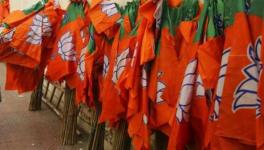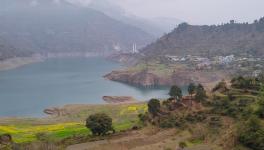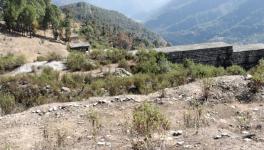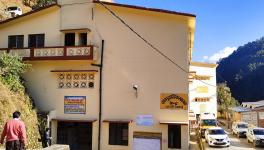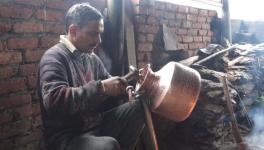Uttarakhand Polls: Ghost Villages, Symbols of Govt Failure and Neglect of Hilly Areas
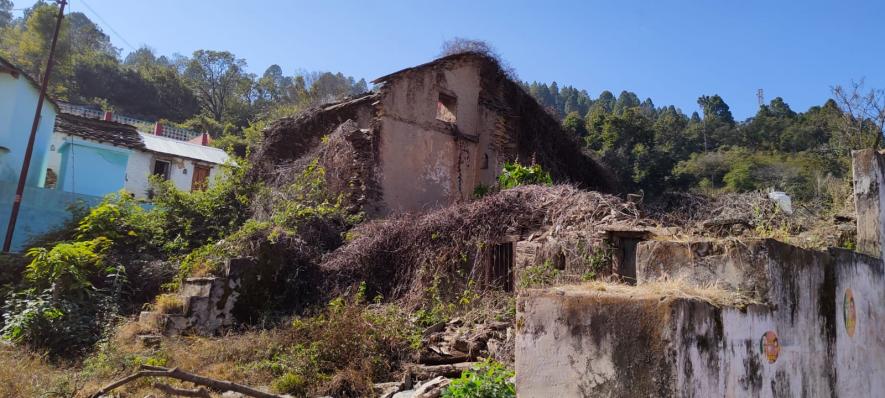
It has been 22 years now since the formation of Uttarakhand as a state. In 2001, people had expected that the formation of a separate state would mean development and prosperity, but today the hills are gradually becoming deserted. With more and more people abandoning the hills for sheer survival, hundreds of villages have become ‘ghost villages’.
Although the government has set up a migration commission to deal with the problem, it continues to make policies on paper, as nothing seems to be happening on the ground.
Newsclick's team visited one such village, Khola, some five-six kilometres away from Srinagar city in Garhwal, from where a large number of people have migrated to urban areas. As a result, only a handful of elderly and women are left in the village.
Read More:Uttarakhand Elections: From Hills to Plains, Farmers are Distressed
NewsClick also visited Pauri and several other districts in the hilly areas where migration is a serious problem. We spoke to people who are left behind to understand why the migration was taking place in such large numbers. Migration has been a part of the development of human society, but this kind of migration does not reflect a normal situation.
In the ongoing Assembly election campaign (voting is on February 14), migration has become a key issue, with most people and political parties highlighting the problem.
Vinod Godiyal, 65, a resident of Khola village, told NewsClick that earlier there were about 60-70 families in his village, but now only 10-15 live there.
Kusum Lata Devi, from the same village, said she spends most of her time in Dehradun with her daughters. She explained this whole cycle of migration and said that the main reason for migration was employment.
“First the young men went out for employment. After they left, we took up farming, but men were needed to plough the fields, so our farming became dependent on people from other villages. But, for those people, working on their own fields was a priority. So, they came to work on our fields only after that. That's why our farming ended.
Read More:Uttarakhand Elections: Villagers Affected by Tehri Dam Still Await Justice
Along with this, people also gave up animal husbandry because due to the end of farming, the area of forest land increased due to the absence of people in the village. As a result, people were afraid to go into the forest. This was the reason why gradually farming and animal husbandry came to an end,” said Kusum Lata.
When asked if there was any possibility of the youth returning, she said: “Why would they come back? Are there any jobs here? Also, now their contact with the village is cut off. They don’t know anything about here.”
Sunita Devi, 75, said: "People are seen in the village only on occasions like marriage, etc. Otherwise, the village remains deserted."
While walking around the village, we saw a young man who was wearing the banner of the ruling Bharatiya Janata Party (BJP). When we talked to him, he said his name was Bhaskar and he lived in Delhi and was visiting the village to attend a relative’s wedding.
Bhaskar said he would go back to Delhi before February 12, whereas polling here was on February 14.
"We don't want to stay outside. Why would we leave our home if we get work here? It is very painful to leave our loved ones and live among unknown people. If the government gives us employment here, we will never leave our homes."
Naresh Chandra Nautiyal of Pauri district, who retired from the revenue department and worked for the 2011 Census, said that migration was the most serious problem in the state. “Today, hundreds of villages have been deserted, there is no one there. The situation here is so bad that if an elderly person dies, we do not even get four young men to give him a shoulder. Four daily wagers have to be engaged for that,” he said.
Nautiyal said the population growth rate in Pauri district had turned negative. He said compared with when he conducted the Census here in 2011 on behalf of the Centre, there was a decline of 10% in the population of Pauri district.
He said migration is not a one-day occurrence, successive governments have provided manure and water to help it grow.
“If I talk about Pauri itself, earlier it was considered a city of workers, but now there is no work. While people had hoped that new and more employment opportunities would be created after the formation of the state, the government has done away with all permanent appointments,” he said.
Read More:Uttarakhand Elections: Hospitals in Miserable State, Patients Left in Lurch
Apart from this, farming has become expensive and unprofitable, which has led to migration of people from the hills to the cities. Lastly, the poor health system has also forced people to move out of rural areas. In the name of improving healthcare, the government has handed over hospitals to private hands on public-private partnerships, which has completely destroyed the health system and made it unaffordable.
What do Government Figures say
In view of the grave migration situation, the then Chief Minister Trivendra Singh Rawat had constituted a Migration Commission on September 17, 2017 to stop migration from villages. The Commission was presided over by the Chief Minister himself. In 2018, the Commission submitted its report to the government, which was later made public.
The report contained several serious revelations. According to the report, maximum migration has taken place in Rudraprayag, Tehri and Pauri. The Commission conducted a survey of 7,950 gram panchayats and submitted a detailed report, listing the reasons for migration and measures to stop it. As per the report, about 1,000 villages in Uttarakhand had become ‘ghost villages’.
The report said that even today, 43% people in rural areas are engaged in agriculture while 33% people work as labourers.
Giving reasons for large-scale migration, the report had said that about 50% people were migrating for livelihood reasons,15% were migrating from hilly areas for education, and 8% were leaving because of poor health services.
The report said the largest number was of migrating youths. It also said that 70% people were migrating from village panchayats to the state itself, while 29% were migrating outside the state. About 1% migrated abroad. To improve the situation, the report suggested a new policy for 35 blocks of the nine hill districts of the state, but that policy is yet to take off.
The government also prepared a migration prevention plan and for this a team was also formed at the district level, which was headed by the District Magistrate. But, this plan was made only on paper. Apart from this, many guidelines were also given, but nothing appeared to happen on the ground.
After the coronavirus pandemic, the government had released a new report in which it claimed that a large number of people had returned to villages. But the truth is that the large number of people who had come back to the state, have migrated again due to lack of any concrete policy. Those who stayed back are also planning to leave at the earliest.
What do Experts Say
Economist and Head of Department of Economics, Doon University, Dr. Rajendra Prasad Mamgain, who has done in-depth studies on the problems of migration and workers, said: “There are two types of migration, one positive and the other negative. In positive migration, people migrate to live a good life which is a normal process in human development, But, but when they migrate in distress then it is negative, which is now visible in the state. Today, people are leaving rural areas because of lack of facilities like employment, education and health.”
“This migration is taking a heavy toll on the state’s economy,” he said, adding that “when there is a migration from villages, it consists of a large number of women who work in agriculture in villages and contribute to production. But when they move to the cities, we are not able to employ them that way. So, we are forcing a large workforce out of production, which could have contributed a lot to our GDP.”
He said the hills are continuously getting deserted while the plains are seeing a rise in population, which is also a danger for the demography of the state.
Mamgain said to put a stop to migration, first of all, the government will have to provide education, health and better roads at the block level in the hilly districts. Second, to make hill farming profitable, there should be emphasis on consolidation and collective farming. Most importantly, the government needs to formulate a hill development policy.”
He further said: “It is not that only our people are going out, a large number of people from other states are also coming here. All the development work being done in the state includes builders, masons, electricians etc., who are from other states. We can replace them with our workforce but they are not skilled. First, we need to skill our workforce.”
When reminded that the Central government is already running skill development programmes in the states, Mamgain said that those were “a complete failure. There is no skill training in it.”
S P Sati, geologist and professor at Doon University, said: “This migration is going to become a very serious problem for the state and governments in the future. The government should take immediate concrete steps to stop it. Otherwise the way people from the hills are migrating and coming down is leaving agriculture deserted, which is also dangerous for the ecology.”
“To stop this, the government should consider the farmers in the hills as social workers and give them incentives in return for farming so that they farmers do not leave agriculture,” he said.
Well, as of now, the opposite is happening on the ground. Leave aside incentives from the government, it is not even giving a fair price for the farmers’ produce.
One thing was clear after talking to people across the state, that these ghost villages are symbols of the state and Central governments' failure and neglect of the hills. Because even after migration at this huge level and the government making continuous claims to stop it and not doing anything on the ground, proves that this is not a priority for them.
Although every party is speaking on this issue in this election battle, the question is whether after coming to power, the basic problems of education, health and employment will be tackled or not or will once again the hill people will bear the brunt of migration amidst shower of jumlas (hollow promises)?
(Translated from Hindi by Aditi)
Get the latest reports & analysis with people's perspective on Protests, movements & deep analytical videos, discussions of the current affairs in your Telegram app. Subscribe to NewsClick's Telegram channel & get Real-Time updates on stories, as they get published on our website.












